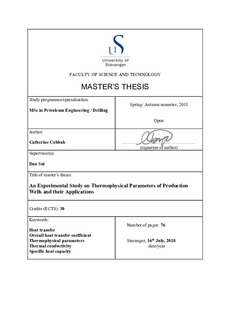| dc.contributor.author | Cobbah, Catherine | |
| dc.date.accessioned | 2018-10-24T11:58:40Z | |
| dc.date.available | 2018-10-24T11:58:40Z | |
| dc.date.issued | 2018-06 | |
| dc.identifier.uri | http://hdl.handle.net/11250/2569336 | |
| dc.description | Master's thesis in Petroleum engineering | nb_NO |
| dc.description.abstract | Transient pressure and temperature behavior in a wellbore develops as hot fluids from the reservoir move upward, exchanging heat with the surrounding formation. Because of heat exchange between the production fluid and surrounding formation, the temperature profile in the wellbore does not remain constant with time. This type of heat transmission is involved in drilling, geothermal wells and in all production and injection operations. In certain cases, quantitative knowledge of wellbore heat transmission is very important. Wellbore components such as tubing, cement, casing and annular fluids play a major role in this heat transmission and to be able to quantify this will require knowledge on the thermophysical parameters of the wellbore components. In this study, experiments were performed using the C-Therm TCi thermal conductivity analyzer and Tenney Junior Test Chamber to measure the thermophysical parameters of wellbore components, specifically, thermal conductivity, effusivity and specific heat capacity in different temperature conditions. Linear and Polynomial correlations were derived and implemented into a wellbore heat transfer model for a single phase oil production scenario, based on the wellbore heat transfer model presented by Hasan, Kabir, and Wang (2009) [1]. Parameter sensitivity tests show that as the flowrate of the produced fluid increases, the rate of heat loss of the fluid decreases and the rate of fluid temperature reduction is lower for higher production times. It is also shown that Flyash as a cement polymer provides better thermal resistance than the other cement systems (G-class, GGBFS and W50). When crude oil was replaced with distilled water as producing fluid, the water experienced minimal heat loss from the bottom to the surface of the wellbore. The findings from this study are important for material selection for geothermal well design. | nb_NO |
| dc.language.iso | eng | nb_NO |
| dc.publisher | University of Stavanger, Norway | nb_NO |
| dc.relation.ispartofseries | Masteroppgave/UIS-TN-IEP/2018; | |
| dc.rights | Navngivelse 4.0 Internasjonal | * |
| dc.rights | Navngivelse 4.0 Internasjonal | * |
| dc.rights.uri | http://creativecommons.org/licenses/by/4.0/deed.no | * |
| dc.subject | petroleumsteknologi | nb_NO |
| dc.subject | petroleum engineering | nb_NO |
| dc.subject | boreteknologi | nb_NO |
| dc.subject | thermophysical parameters | nb_NO |
| dc.subject | overall heat transfer coefficient | nb_NO |
| dc.subject | thermal conductivity | nb_NO |
| dc.subject | specific heat capacity | nb_NO |
| dc.subject | production wells | nb_NO |
| dc.title | An Experimental Study on Thermophysical Parameters of Production Wells and their Applications | nb_NO |
| dc.type | Master thesis | nb_NO |
| dc.subject.nsi | VDP::Teknologi: 500::Berg‑ og petroleumsfag: 510::Petroleumsteknologi: 512 | nb_NO |

